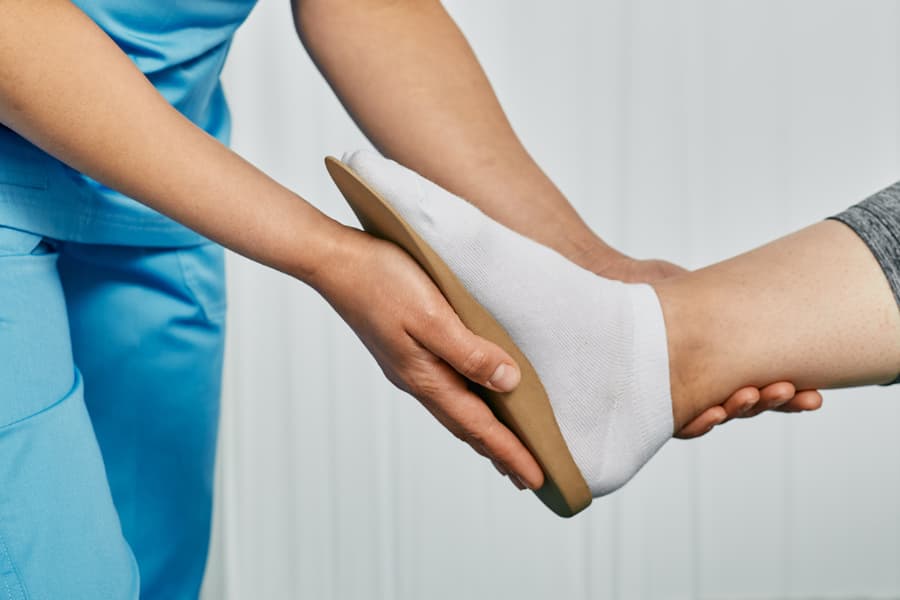
If you’ve ever had a sprained ankle or an ingrown toenail, you may have seen a specialist known as a podiatrist. These doctors focus on conditions that affect the feet and ankles. Like other types of doctors, they rely on the support of medical assistants to deliver excellent patient care and keep their medical offices running smoothly. Podiatric medical assistants are in demand, and students who focus on this specialty may eventually earn a higher medical assistant salary.
Prism Career Institute offers an outstanding medical assistant program in Pennsylvania and New Jersey. Here, we discuss the responsibilities of a podiatric medical assistant and the benefits of this specialization.
What Does a Podiatric Medical Assistant Do?
A podiatric medical assistant supports doctors who treat foot and ankle conditions, known as podiatrists. A podiatrist can diagnose and treat many common conditions, such as bunions, corns and calluses, fungal infections, diabetic foot wounds, fractures, and sprains. Like all medical assistants, these healthcare professionals perform a range of clinical and administrative duties.
As a podiatric medical assistant, your responsibilities might include:
- Greeting patients and showing them to exam rooms
- Documenting patient symptoms and medical histories
- Measuring patient vital signs, such as blood pressure or heart rate
- Taking blood samples
- Assisting a podiatrist with minor procedures, such as removing ingrown toenails
- Placing foot or ankle braces, splints, or orthotics
- Applying topical medications to the feet
You also may have administrative or clerical duties, such as:
- Updating medical records
- Scheduling patient appointments
- Processing patient co-pays
- Submitting claims to insurance providers
- Ordering or restocking medical supplies
Podiatric medical assistants also may help with patient education, such as providing a list of over-the-counter treatments for common foot issues.
Where Do Podiatric Medical Assistants Work?
Medical assistants are needed in all types of healthcare settings and work with nurses and nurse practitioners in addition to physicians. A podiatric medical assistant can apply for positions at:
- Podiatry clinics and practices
- Hospitals
- Family medical centers
- Urgent care centers
As a medical assistant, you may work for a general or specialty podiatry practice. Podiatrists may focus on treating certain patient populations, such as children, athletes, or people with diabetes. If you work with this type of provider, you may have the opportunity to gain even more advanced training and knowledge.
Career Outlook for Podiatric Medical Assistants
Students in medical assistant programs can look forward to working in a dynamic industry with plenty of job opportunities. By focusing on a medical specialty like podiatry, you may be able to earn a higher salary as a medical assistant.
According to the U.S. Bureau of Labor Statistics (BLS), median earnings for medical assistants are $38,270 a year. The highest 10% of earners in the field, however, could take home over $51,710 annually, and specializing in podiatry could boost earnings.
As older workers retire and baby boomers need more health services, the healthcare field will continue to grow rapidly. The BLS predicts employment opportunities for medical assistants will increase by 16% over the decade, which is much faster than average. This will translate into about 123,000 job openings each year, on average, for medical assistants in the United States.
Comprehensive Medical Assisting Training
Prism Career Institute in Pennsylvania and New Jersey offers hands-on, career-focused training for students who want to become medical assistants. Providing 720 hours of training, our medical assistant program can be completed in as little as ten months. With a combination of classroom instruction and lab-based training, instructors cover foundational topics such as:
- Anatomy and physiology
- Phlebotomy
- Electrocardiography (EKG)
- Medical law and ethics
- Pharmacology
- Patient history and vital signs
- Cardiopulmonary resuscitation (CPR)
- Clinical procedures
- Patient hygiene and infection control
- Records management
Once students complete 420 lecture hours and 150 lab hours, they move on to medical assisting externships, where they have the opportunity to put their knowledge into practice under the supervision of an experienced medical professional.
Students who graduate from Prism Career Institute’s medical assistant program are eligible to sit for the Certified Clinical Medical Assistant (CCMA) exam. An education at Prism Career Institute can be a first step toward specialties such as podiatric medical assisting, but some additional training may be required.
Apply to Prism Career Institute Today
Whether you want to focus on podiatric care or another specialized branch of medicine, medical assistant training is the first step. At Prism Career Institute, we help students prepare for rewarding careers in healthcare. Offering flexible course schedules and supportive career services, Prism Career Institute is dedicated to your success. We offer medical assistant programs at our campus locations in Philadelphia, PA, Cherry Hill, NJ, and West Atlantic City, NJ. For more information or to get in touch with a member of our admissions team, contact us today.
